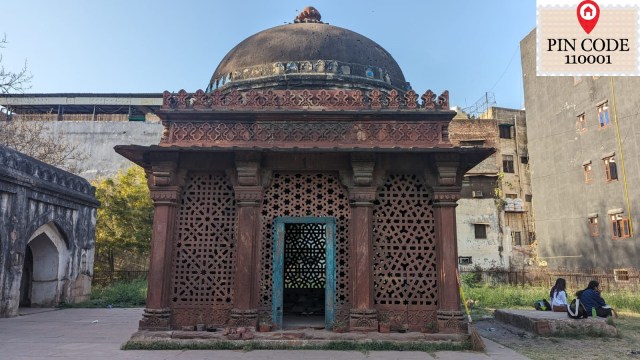A quiet, desolate Lodhi-era shrine in South Delhi that comes alive on Holi
Historian and author Rana Safvi considers the 15th-century dargah as “by far the prettiest I have seen”. She tells The Indian Express: "It’s like a vermillion-mark of spirituality in the surrounding area."
 The dargah of Hazrat Yusuf Qattal — a Sufi saint from the Lodhi era — who also saw Babur setting the foundation of the Mughal empire in India. (Express Photo by Deepika Singh)
The dargah of Hazrat Yusuf Qattal — a Sufi saint from the Lodhi era — who also saw Babur setting the foundation of the Mughal empire in India. (Express Photo by Deepika Singh)Saket in South Delhi is famed for its swanky malls and upmarket cafes. But take a short walk from there, navigating the heavy traffic and congested lanes, and you will be greeted by an oasis of calm in a park housing an assortment of historical structures.
The most prominent among them is a red sandstone monument, standing out owing to its intricate lattice work on all sides and remnants of blue tiles adorning its dome. This is the dargah of Hazrat Yusuf Qattal — a Sufi saint from the Lodhi era who also saw Babur setting the foundation of the Mughal empire in India.
Historian and author Rana Safvi considers the 15th-century dargah as “by far the prettiest I have seen”. She tells The Indian Express: “It’s like a vermillion-mark of spirituality in the surrounding area. Though very small, it is exquisite and very well-preserved.”
According to local legend, the dargah was built on the place which served as the Sufi saint’s Chillagah – the spot where he performed meditations – in his lifetime. In her book 14 Historic Walks of Delhi, author Swapna Liddle, too, writes: “He (Qattal) probably lived in this area because he is believed to have performed ablutions at Satpula (a Tughlaq-era dam situated nearby) too.”
Like Safvi, Liddle is also impressed by the architecture of the dargah. “The tomb is an attractive structure. Notice the beautifully carved, red sandstone pillars and jalis. The design on the parapet around the roof is derived from kanguras… Above, around the dome, there is a band decorated with blue tiles,” she writes further in the book.
Other structures on the premises include a mosque, a congregational hall, and a few unnamed graves, including one surrounded by six pillars, hinting at the presence of a chhatri (domed kiosk) in better days.
Unlike other dargahs of Delhi — from the iconic Hazrat Nizamuddin dargah to more local, lesser known shrines, which host urs and qawwalis — this one is relatively quiet, empty and desolate, with the occasional group of children seen playing a game of hide-and-seek or a local resident walking their dog on the ground draped in a carpet of dried, yellow Neem leaves.
But, this dargah comes alive right before the festival of Holi.
According to Asif Khan Dehlvi, a long-time Mehrauli resident who regularly conducts heritage walks in Delhi, “The local residents offer gulaal, chirag (lamp), and milk here on Holi. It is their way of seeking the blessings of ‘bade buzurg (senior members)’ – a moniker used for Sufi saints by long-time Delhi residents. I have not seen this practice at any other dargah in Delhi although Dewa Sharif in UP, a few kilometres ahead of Lucknow, is famed for its colourful Holi celebrations.”
Safvi, too, says, “It has great significance in the lives of the locals who offer flowers and light incense on Thursdays. They regard him as their Dada Pir. On Holi, they come and smear his dargah with colour.”
Commenting on the architecture of the dargah, Dehlvi says it is similar to that of a few other dargahs of Delhi. “Notice closely and you will see the resemblance with the Nizamuddin or Chirag Dilli Dargah. They also have this jali work and pillars. But the red colour certainly makes this one stand out.”
Liddle writes that it appears the tomb of Yusuf Qattal was built on a raised platform. “But the ground level of the surrounding area rose over the centuries through the deposition of silt brought by a stream in the area. The lower levels of some of these buildings… were revealed when the earth was removed during conservation work some years ago,” she states in her book.







